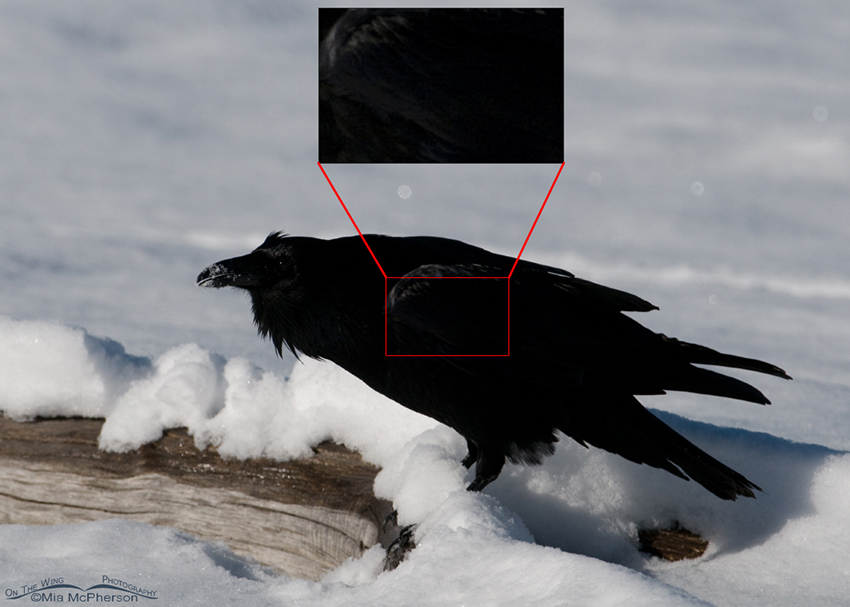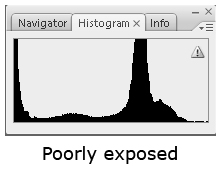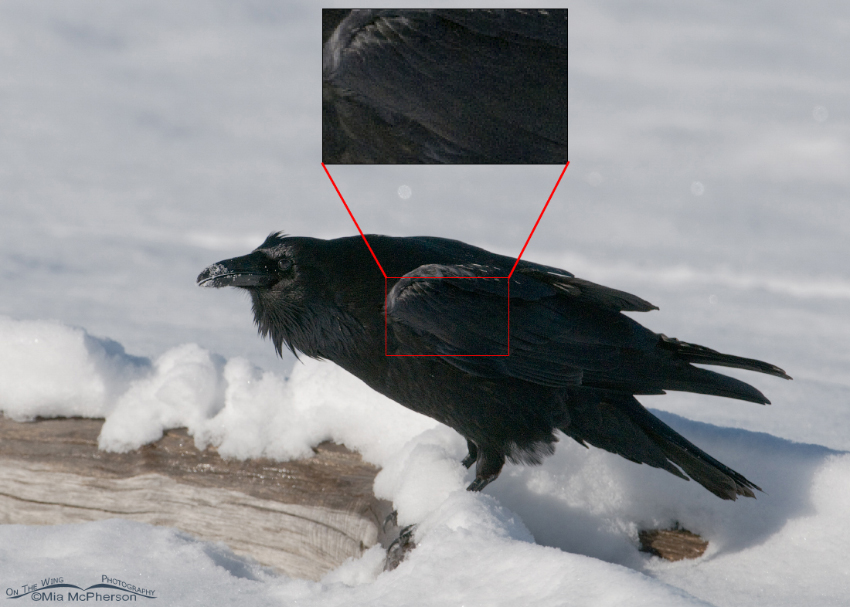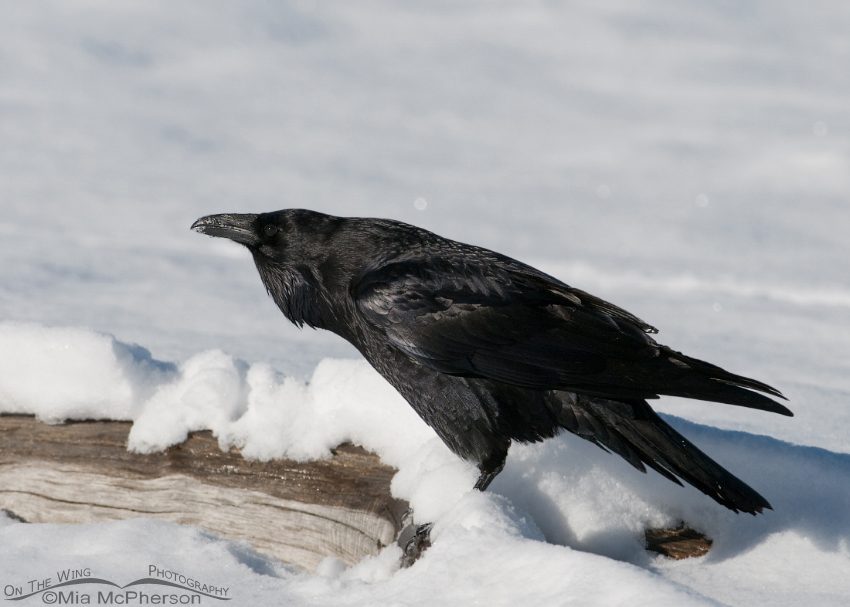Photographing dark birds such as this Common Raven is a challenge and knowing how to expose properly as well as getting the right angle of light is critical in producing a quality image.
 Calling Common Raven in snow original – Nikon D300, f6.3, 1/4000, ISO 400, 0.0 EV, Nikkor 200-400mm VR with 1.4x TC at 285mm, natural light, not baited or called in
Calling Common Raven in snow original – Nikon D300, f6.3, 1/4000, ISO 400, 0.0 EV, Nikkor 200-400mm VR with 1.4x TC at 285mm, natural light, not baited or called in
I have posted before about the importance of honest self critique and that will be discussed in this post too. The exposure of this very dark bird is even more difficult because of the high contrast between the dark raven and the bright white snow.
The Common Raven image above is not properly exposed, in fact it stinks. The blacks are blocked up and very little feather detail is evident even though the bird is sharp. This image belongs in my delete bin but it can be used as an example of honest self critique. The expanded view area above the bird shows the area outlined in red at 200% and except for the upper left hand corner of the expanded view I barely see any detail.
I brought this image into Photoshop, cropped it slightly then masked the bird and sharpened it, no other adjustments were made.
 This Photoshop histogram shows how poorly exposed this image is, the tall column of blacks on the edge of the left side shows how badly the blacks are blocked up. The histograms in our cameras can show us poor exposures in the field and by using the histogram exposure compensations adjustments can be made.
This Photoshop histogram shows how poorly exposed this image is, the tall column of blacks on the edge of the left side shows how badly the blacks are blocked up. The histograms in our cameras can show us poor exposures in the field and by using the histogram exposure compensations adjustments can be made.
By using my skills of self critique I can say there were two things that could have made this image a keeper, 1) a better exposure and 2) a better light angle on the birds itself.
Could this image be saved in post processing?
 Calling Common Raven in snow lightened – Nikon D300, f6.3, 1/4000, ISO 400, 0.0 EV, Nikkor 200-400mm VR with 1.4x TC at 285mm, natural light, not baited or called in
Calling Common Raven in snow lightened – Nikon D300, f6.3, 1/4000, ISO 400, 0.0 EV, Nikkor 200-400mm VR with 1.4x TC at 285mm, natural light, not baited or called in
This is the same image processed differently. I brought the file into Photoshop and increased the exposure by +.15, used the fill light slider and bumped it up to +25, I also used the tone curve slider for the blacks & shadows and raised them by +40 to raise the exposure of the darks within the image. I masked the bird and sharpened it using the same procedure as the top image.

This is the Photoshop histogram after post processing in Photoshop, the blacks are no longer blocked up towards the left edge of the histogram. Looking at the expanded view at 200% does show feather detail and areas of the raven don’t look like a black featureless subject.
The problem? By increasing the exposure of this Raven in post processing I have introduced “noise” and it is right on the edge of “color noise”. I find this amount of noise unacceptable in my images. In both the expanded view and normal view I can see and detect that noise as blocky areas that just do not appear natural and that ruins this image for me and because of honest self critique this file is delete bin bound. The quality of this image is not acceptable to me even after post processing.
Well-meaning friends, relatives and non-photographers might think that this is a good image and say “Wow” or “great image” but after spending years honing my skills and time spent critiquing myself, I know it isn’t “great”.
I use Noise Reduction software sparingly, I very rarely ever apply it to my subject because it can cause the subject to look unnatural and unrealistic. Used excessively Noise Reduction software can give the feathers a melted appearance and it also ruins the fine details I like to see in my images. Granted, I am not very skilled at noise reduction and I feel that by getting my exposure correct in the field there is very little need for me to use it or become proficient at it.
 Calling Common Raven in snow – Nikon D300, f6.3, 1/2500, ISO 400, +0.3 EV, Nikkor 200-400mm VR with 1.4x TC at 285mm, natural light, not baited or called in
Calling Common Raven in snow – Nikon D300, f6.3, 1/2500, ISO 400, +0.3 EV, Nikkor 200-400mm VR with 1.4x TC at 285mm, natural light, not baited or called in
After looking at my cameras histogram I made a slight adjustment to my exposure compensation (EV) of +0.3 which brought out more detail in the black plumage and while this exposure isn’t perfect I am pleased with it. This image was taken just four frames after the top image. The raven had moved slightly and that improved the angle of light falling on the bird too. I could have increased the exposure another step but in doing so I would have risked blowing out the whites of the snow. If I had blown out the snow I could have reduced the exposure in post processing but to be honest I would rather keep all my post processing adjustments to a minimum.
Ideally I would have liked to have started photographing the Common Raven about 10 feet back towards the west for a better light angle but sometimes other traffic can get in the way of doing that after the first stop. Just another of the frustrations bird photographers can face.
I know I am critical of my own images but every time I do an honest self critique I learn about improving my photography and that is a good thing.
Life is good.
Mia
Click here to see more of my Common Raven photos plus facts and information about this species.


Thanks for great pleasure seeing your photos and having you tell us what you were doing, how you were doing it, where you were and some of the mechanics. I am contemplating a little birding blog but I’m intimidated by your talents. Love your work.
Thanks very much for this, Mia. My reading of histograms is *still* not intuitive. I recognize the extremes, but couldn’t pass a test based on viewing the histogram alone. I have to work at it, and I confess that I will cheat my RAW images a bit in post processing if they’re under-exposed. You consistently give me a standard to admire, respect and work toward. Happy 2013!!
Mia, I also meant to make the comment that Adobe Lightroom has some excellent noise reduction engines built its software, it just takes some practice to be able to use them. I purchased Lightroom and used it for a month or two. But then I went back to just using PS because I really don’t like using two softwares, when PS for me does everything. Also, Lightroom has a language and system of its own which further complicates things. Once in a while though, I will import an image into Lightroom to deal with the noise matter. But I admit it’s burdensome to have to switch between the two.
Hi! The final photo is so great. It is a beautiful bird! Even if sometimes not so nice! Ha ha Great image! Happy New Year!
Dear Mia, You’ve done it again. I have never had a chance to see a chucar or even a very good photo of one… and here you’ve given me views of so many movements of the bird… the character is revealed. And the raven is a special treat. For someone like me, photos like yours are the only way I can truly explore the wonderful world of birds. I am truly grateful and I hope your NEW YEAR brings back triple all your kindnesses that you share with us all. HAPPY NEW YEAR!
A great lesson in the virtues of shooting with available, natural light.
same problem here with black birds, but when it s cloudy, it s easier to shot because clouds can make a beter diffusion of the ligth, but not to much clouds to have enougth ligth
for posttraitement with photoshop, the filter “viveza” works very well to change the exposure only for some range of colors, if you havent it, i can give mine to you, it s for pc photoshop
bye
Not critical, learning and refining! You sound so much like me it is pathetic. I just finished the first of a lighting class online and learned a lot. Can I apply it – not so much YET but did go shoot some last night trying to figure it out. I’m still total novice at reading and adjusting historgrams – that will be my next class I take! Thanks tho Mia, this helps a lot as well.
Nothing further then he uttered
not a feather then he fluttered
till I scarcely more than muttered,
this bird has blown my histogram before
then the bird said, “nevermore!”
—-
You nailed the last shot. Really tough shooting situation for sure! (and forevermore)
This is a very well-written and useful post for beginners like me Mia. I now want to try it out on my next birding trip
Thanks for the great lesson Mia! I have a very long way to go on getting great images of my subjects, learning how to use my histogram and adjusting my exposure compensation. Stark black and white contrasted images are the toughest and you have demonstrated the problem and given the solution with exceptional clarity! That last image of the raven is gorgeous.
Yea, you can do it too. Absolutely brilliant.
Your info was amazing and the mask really did the job..We have lots of ravens here in Pagosa Country and they are very interesting birds to watch. Great job.